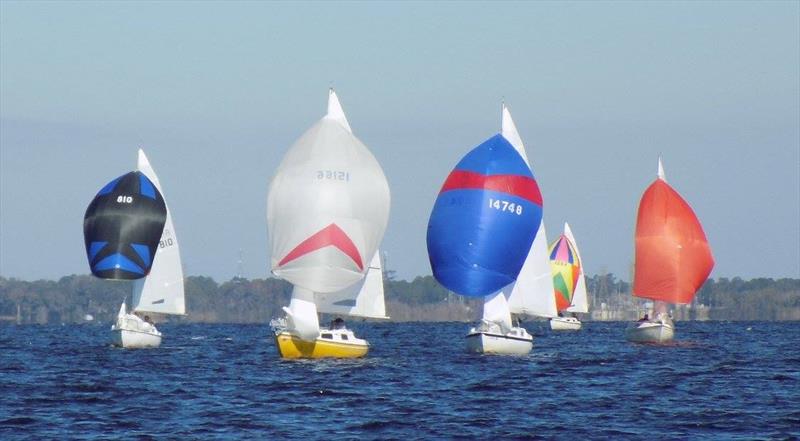
An interview with Mike Loughlin on the 2022 San Juan 21 North American/Eastern Nationals
by David Schmidt 11 Jan 2023 16:00 GMT
January 11, 2023

San Juan 21s in downhill action on the waters of Lake Monroe © Lake Monroe Sailing Association
In 1970, designer Don Clark set to work on the plans for a tidy, trailer-able sloop that could be day sailed, raced, and even cruised aboard for a weekend. His solution, the San Juan 21 employed a retractable swing keel, a kickup rudder assembly, and an easily stepped and rigged spar. The Clark Boat Company, in Seattle, built the early boats, and the company soon added an additional factory in New Bern, North Carolina. Mark I models hit local marinas in 1971, and the Mark II version arrived in 1974.
All told, some 2,700 San Juan 21s were built; the design went out of production in the late 1980s. Today, the class enjoys a spirited following and active racing on both coasts and into Canada.
Take, for example, the 2022 San Juan 21 North America/Eastern Nationals, which are being hosted by the Lake Monroe Sailing Association from January 12-15, 2023 on the waters of Lake Monroe.
I checked in with Mike Loughlin, regatta chair of the 2022 San Juan 21 North American/Eastern Nationals, via email, to learn more about this exciting national-level One Design regatta.
Can you please tell us a bit about the culture of the San Juan 21 class and the kinds of sailors one might encounter at a nation-level class event?
We are expecting sailors with all levels of sailing skills from all over the U.S. In our fleet in Florida, we have World and National Champions from other classes such as, Lightnings, Catalina 22 and Flying Scots, so the competition will be strong within the fleet.
How many boats are you expecting on the starting line(s) of this year's North American Championship?
Currently we have 18 teams currently registered, but we are expecting 25 to 30 teams when we get to the line.
Generally speaking, what kinds of conditions can sailors expect on the waters of Lake Monroe in early January?
Lake Monroe could be so calm that you would hear boaters talking to one another on the water. But when reviewing history, last January we had winds steady at 8 [knots] up to 12 knots. If those winds are available during the regatta, it should be very competitive.
Do you see local knowledge playing a big or small role in the regatta's outcome? Can you please explain?
Local knowledge will play a small role in the outcome. This is lake sailing with a difference, there are no mountains leading down to the water's edge to divert wind as traditional glacier lakes nor many structures that cast large shadows over the course.
Mainly flat land surrounds Lake Monroe so the wind flows steady. Lake Monroe is on the St. John's River, but the race committee places the course away from the flow so that does not play a major factor.
In the ideal world, how many races do you and the other organizers hope to score? Also, will these be straight windward-leeward courses, or will the courses also employ reaching legs (triangles)?
The course will be windward-leeward utilizing a gate so competitors can split and attack from different sides of the course.
There will be two classes, All Sails, with spinnaker and working sails. The Organizing Committee is shooting for as many races as possible, but we will have to see what Mother Nature hands us on regatta day.
If you could offer one piece of advice to visiting (and local) sailors, what would it be?
Have patience. This is Florida, the saying is, you can wait an hour and the weather will be completely different.
On Lake Monroe we have a natural East Coast breeze that hits the lake in the afternoon with nothing blocking its path.
Patience is the key word.
What about onshore entertainment? What can sailors look forward to once the finishing guns have gone silent each day?
The Lake Monroe Sailing Association is hosting a BBQ on Thursday the 12th for arriving guests with burgers, hotdogs, and drinks.
On Friday after racing, the teams are invited to the competitor's dinner at The Yardery in Sanford. Sanford is a great town for teams to explore. There is a lot going on in this small town, with restaurants, breweries, and plenty of entertainment.
Saturday or Sunday during the awards ceremony, we will fire up the grill again, so competitors do not go home on an empty stomach.
Can you please tell us about any efforts that the club has made to green-up the regatta and generally lower its environmental wake?
The Lake Monroe Sailing Association participates in lake cleanups. Trying to keep Lake Monroe clean is a major priority for the club.
We are also discouraging single-use containers for water by offering competitors to fill their bottles out of the water cooler.
Is there anything else that you'd like to add, for the record?
The Lake Monroe Sailing Association [LMSA] has been offering regatta and events since 1985. The club was created by sailors that wanted to keep sailing alive and well on Lake Monroe. The club hosts several regattas a year along with some Regional and National events.
Some sailors may remember the day when Lake Monroe hosted the largest inland regatta, [the] Citrus Bowl Regatta and later the Red Lobster Regatta. These events brought sailors from all over the world to compete and upwards of 300 to 500 boats. LMSA hopes by hosting events such as the San Juan 21 North Americans, we can generate more excitement for future regattas on Lake Monroe.